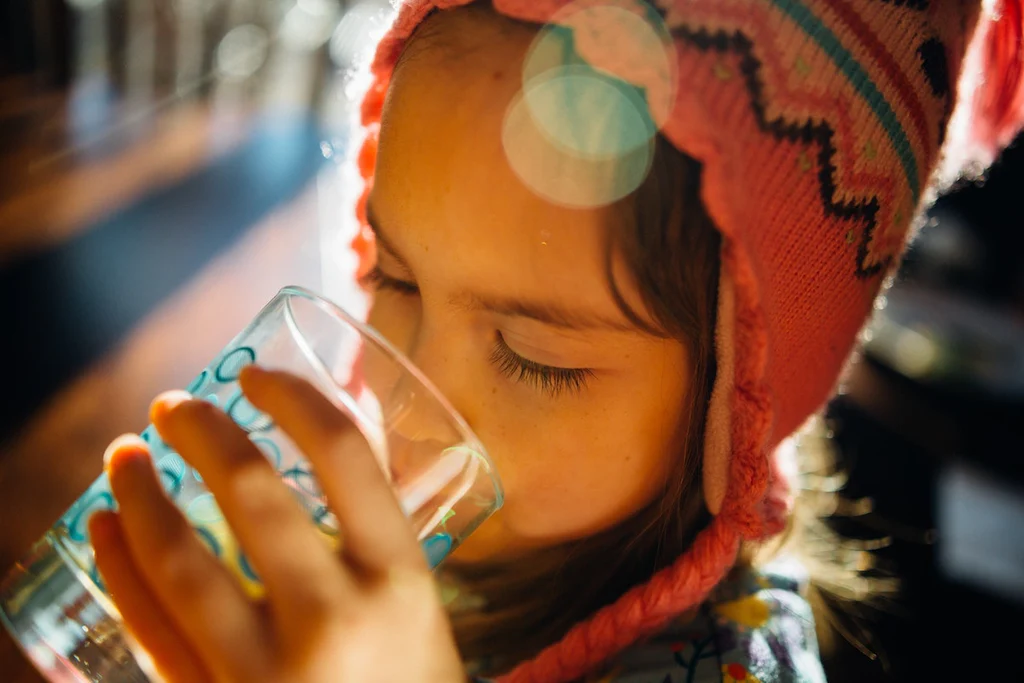Kids are constantly on-the-go, rarely stopping for breaks, least of all to drink water. Most prefer the sugary sweetness of juice or sodas over the hydrating benefits of water. Lack of water will eventually lead to signs of dehydration in children that can negatively affect their physical and mental health. It’s important to teach kids the value of drinking water and staying hydrated, provide them with safe drinking water, and encourage healthy water habits from a young age.
Kids aren’t normally on the lookout for signs or symptoms of whether they’re drinking enough water or not. They focus more on whether or not they feel good and if it interferes with things they want to do. Or, depending on their age, they may not be able to communicate their dehydration symptoms with you. In addition to monitoring how much water is consumed on a daily basis, look for these potential signs of dehydration in children.
- Sunken eyes and cheeks – A child’s physical appearance is one of the key indicators of moderate dehydration. Sunken eyes or cheeks are a telltale sign that your child isn’t getting enough water and they need to bump up their fluid intake.
- Irritability – Although irritable behavior can be linked to numerous things in children, hunger or thirst are usually the top two signs of moderate dehydration, especially for babies and toddlers. If they are showing signs of listlessness, consider how much water they’ve had to drink that day.
- No tears when crying. Fluid loss in small children can quickly lead to tearless cries. Babies or younger children who cry without tears may be experiencing moderate to severe dehydration. Consider other factors like hot weather or confined spaces that may be inhibiting their ability to produce tears as well or cause them to become dehydrated more quickly. If this is the case with your child, rehydration will be key in order to bring them back to a healthy state.
Although these symptoms are generally mild and can be taken care of by increasing water or fluid intake, there are other moderate signs and reactions to be aware that your child may be experiencing severe dehydration. These include diarrhea for longer than 24 hours, inability to keep down fluids, and being less active than usual.
It’s common for kids to tire themselves out with their high energy and level of activity throughout the day. It can cause them to feel overheated, especially when not consuming enough water. Additionally, mild dehydration can occur when kids aren’t feeling well. If they’re vomiting or have diarrhea, it’s difficult for them to keep enough water and electrolytes in their system to stay hydrated. The same goes for excessive sweating or increased urination. When kids expend more water than what they take in, dehydration is inevitable. Even when they don’t show any of these signs, keeping children regularly hydrated is the healthy way to go.
Encouraging Healthy Water Drinking Habits from a Young Age
Once a child is able to pour their own water, it’s important to discuss the importance of staying hydrated in a way that will resonate with them. Whether you are trying to get kids to drink more water at school or at home, there are many ways you can entice your little ones to stay hydrated. Here are a few ways to help teach your kids about the benefits of water and get them to drink more during the day.
- Lead by example. If your kids notice you drinking more water on a regular basis, it’ll show them they should, too. Make a point to drink water together so you can monitor how much they are drinking at home and pack a reusable water bottle for them to take to school.
- Limit sugary beverages at home. Kids who have access to soda, juices, and other colorful drinks won’t be as interested in drinking water when given the choice. Limit how many of these beverages you have on hand and save them as special treats instead, if at all.
- Add flavor to water. Many kids claim they don’t like the flavor of water. Jazz it up with fruit or cucumber slices to make it fun with a touch of natural sweetness to encourage them to drink more water on their own.
- Designate a special water bottle or cup. Buy a reusable water bottle or cup with their favorite color or character on it that they can use when filling up throughout the day and take with them on the go.
- Encourage them to drink water after playing outside. When the temperature gets hotter, kids rarely want to take a break. Since they’re losing a lot of sweat and electrolytes, ensure they take a breather and a water break on a regular basis.
- Start a family challenge. Work together to design a chart that shows how much water each person drinks per week and offer small rewards, like a sticker or an extra 15 minutes of screen time, to those who stay hydrated best.
Creating habits from a young age amplifies the importance of drinking water so that it becomes the norm as kids grow older. They may need some motivation in the beginning with natural flavorings or mini challenges, but over time, they’ll be accustomed to staying hydrated without a second thought, which will help them focus better and stay more energized in school, during sports, and when hanging out at home.
Why Safe Drinking Water for Children Is Important
Providing children a safe drinking water solution is important because kids’ immune systems are still developing and are more susceptible to contaminants found in water. Knowing what’s in your tap water and where it’s sourced from is important. We suggest getting a faucet filter for your home to help purify your water before it ever makes it in your water cup. There are safety measures in place for the amount of pollutants that can be part of a public water supply, but these may fail to meet the standards due to a variety of factors.
Lead Exposure May Lead to Birth Defects
Whether you realize it or not, there are many dangers of big city water quality. Many cities face problems with old pipes, either due to the materials they’re made of and/or how much they are deteriorating and leach chemicals and other contaminants into the water. Most city water systems were constructed with lead pipes, which are still in use today in some areas, and can cause harm to the body. Although there has been progress to update these systems, older homes also may use lead pipes, which means that as water travels from its original source it can leach into your water before it comes out of the tap.
Lead exposure is especially dangerous among kids and women who are pregnant. It has been linked to several birth defects, including adverse effects on cognitive and behavioral functioning. It can lead to low birth weight or premature births for women who are pregnant and can increase the risk of cancer, spina bifida, and cleft palate in newborns. The U.S. Environmental Protection Agency also states that contaminated water poses increased risk for children for acute diseases, such as a gastrointestinal illness, learning disorders, and endocrine disruption due to how much water they take in compared to their body weight.
Related: Ensure Safe Drinking Water During Pregnancy
Developing Immune Systems Have a Higher Risk of Health Effects
In addition to lead, there are microbial contaminants like bacteria and viruses that lead to stomach issues. Since children’s immune systems aren’t as strong as older adults, they are more susceptible to have a negative reaction to certain viruses and bacteria like giardia and E.coli often found in water sources.
As part of the solution to reduce the amount of contaminants found in tap water, chemical byproducts are used, which can also lead to adverse health effects, even as they eliminate harmful microbial elements. The most common disinfectants are chlorine, chloroform, and/or other trihalomethanes, which consumed in high levels, can lead to bladder cancer and development effects in children. It’s also been linked to increased risk of neural tube defects and oral clefts in babies.
A study conducted by the Division of Health Studies, Agency for Toxic Substances and Disease Registry in Atlanta, GA presented evidence that showed a link between tap water treated with chemical solvents and low birth weight, preterm births, and birth defects, among other complications during pregnancy and in the early stages of life.
Each municipality is responsible for sharing a Consumer Confidence Report that lists where water is sourced from, what chemicals are found, and how the water is treated. Water that may be deemed safer for older adults may still pose risk for children due to how much water they consume and how well their immune system is developed.
Staying Hydrated with a Purified Water Solution
Drinking water isn’t enough to keep kids healthy since regular tap water may still pose harm. The availability of purified water in the home helps families stay hydrated in a healthier way. FloFaucet is simple to install and easy for everyone to use. It transforms the water that’s been treated from the tap and removes or reduces over 80 known contaminants through a multi-stage filtration system to eliminate lingering particles of lead, bacteria, chlorine, and other chemicals and pollutants that may end up in a water supply.
To keep kids hydrated, they need prompts that motivate them to drink more water and a way that’s easy and convenient for them. Making water that tastes great easily available for children is a way to ensure they stay hydrated. Using FloFaucet also reduces plastic waste in the home that comes from plastic water bottles. It meets these needs on all levels and delivers a cost-effective, simple-to-implement solution the whole family can benefit from on a daily basis.
Sources:
https://www.mayoclinic.org/diseases-conditions/dehydration/symptoms-causes/syc-20354086
https://www.epa.gov/sites/production/files/2015-10/documents/ace3_drinking_water.pdf




